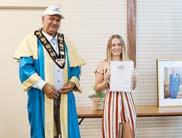Australia’s National Local Government Newspaper
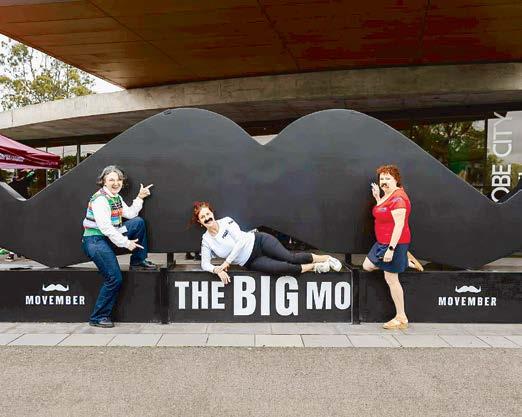


AspartofMovember,agiant moustache-measuringan incrediblesixmetreslonghasbeeninstalledoutside theMoeLibrarybythe Men’sHealthCharity, Movember.
The unveiling of the monstrous Mo came as Latrobe City Council hosted the regional launch event for the Movember Campaign Moustache on Monday 3 November, from 9am to 12pm.
There’s was an opportunity for community members to attend, come along and get a free hair trim, beard trim or a moustache style, listen to the DJ and enjoy the free BBQ breakfast and airbrush tattoos.
The Big Mo is part of Men’s Health Charity, Movember 2025 campaign. Moe has been chosen as the regional location, not just for the play on words, but to shed a light on regional and rural men’s health.
“Having the big Mo down at Moe is more than just a large Mo,” Latrobe City Council Deputy Mayor Sharon Gibson said. “It is creating the conversation on how men who live in the Country have double the health issues that their City “cousins” have. So get down and do the selfie with the big Mo and start the conversation, it might just save lives.”
AplanbytheFederalGovernmenttosupportasuccessfulsaleofRexAirlines(RegionalExpress)isreceivingsupport amongRegionalCouncilsimpactedbytheairline’svoluntaryreceivership.
Regional Express has now found a buyer after the airline was operating under voluntary administration for more than a year.
In a statement, administrators confirmed they had entered into a sale and implementation deed with Air T, a US-based air services company.
Rex was placed into voluntary administration in July 2024, after acquiring $50 million in debt from its largest creditor at the time, PAG.
The federal government had agreed to underwrite continued operations of the passenger service until this December while administrators searched for a buyer.
This week the Government announced details of the financing that it will provide to support the proposal put forward by Air T, Inc. (Air T) to the Administrators of Rex in connection with their bid to acquire Rex.
The move was welcomed by Dubbo Regional Council Mayor Josh Black.
“Council welcomes the announcement from the Hon Catherine King MP, Minister for Infrastructure, Transport, Regional Development and Local Government, and Hon Kristy McBain MP, Minister for Regional Development, Local Gov-
ernment and Territories of Australia regarding a new Australian Government funding program to support regional and remote airports impacted by Rex Airlines’ voluntary administration.
“This initiative will allow us to apply to have the money owed to Council by Rex reimbursed, providing a pathway to recover outstanding payments. Before Rex entered voluntary administration, our Council was owed almost $660,000, so this program represents an important opportunity to restore those funds.
“We also acknowledge the Australian Government’s commitment to regional aviation through its support for Air T’s acquisition of Rex.
As part of this arrangement, the Government will retain security over Rex’s aircraft and simulator fleet, ensuring continuity of regional and remote routes previously serviced by Rex.
“Council staff have worked diligently to manage the financial impact of Rex’s administration, and we are pleased to see this strong response from the Australian Government to safeguard regional connectivity and support local communities.”
“Council remains as creditor to Rex Airlines.”
The Hon Catherine King MP, Minister for In-
frastructure, Transport, Regional Development and Local Government, and Hon Kristy McBain MP, Minister for Regional Development, Local Government and Territories of Australia made the announcement in the first week of November.
King said the Government “would restructure Rex’s existing debt to the Australian Government. Approximately $90 million of existing debt will be carried forward and a new commercial loan of $60 million will be provided to Rex”.
“This will supplement the $50 million being contributed by Air T towards the recapitalisation of the business,” the ministers said.
“In exchange for this financing and to ensure value for taxpayer money, Air T has agreed to a range of commitments aimed at preserving essential regional aviation connectivity and improving governance arrangements.
This will include returning more aircraft to service and increasing the frequency of profitable flights across the Rex network.
“To safeguard this public investment, the Government will retain its security over all Rex’s aircraft and simulator. This will ensure Rex’s Saab fleet cannot be sold without the Govern-
ment’s permission and will continue to service communities across regional and remote Australia.”
Separately, the Government has also announced that it will establish a new program capped at $5 million for local government and regional and remote airports that supported Rex through the voluntary administration process.
“This new program will mitigate financial barriers to these organisations continuing to provide essential services to their communities,” King said.
“Eligibility will be based on the amount owed to the organisation by the Rex regional business when it entered voluntary administration.
“This program is a separate Australian Government initiative and is not part of the negotiations with Air T for its acquisition of Rex.
“This builds on the vision outlined in the Aviation White Paper for the benefits of aviation to be shared across regional and remote Australia, and the extension of Regional Airports Program in the 2024-25 Budget with an additional $40 million for two further funding rounds.”
When Rex Airlines went into voluntary receivership in July 2024 it was a major blow for many regional LGAs around the country. Not only were their airlinks in danger but with many of these regions also creditors, they stood to lose large amounts of money – money no council – particularly regional ones could afford to lose drop. The news in the past week that they have found a buyer and that the Federal Government will continue to help the councils affected – comes as a welcome relief particularly in areas where drought is taking its toll too.
GOOD OIL PAGE ............... page 6
STAFF page 8
TOURISM AND ECONOMICS................page 10-11 RURAL AND REGIONAL page 12-13 METRO AND SUBURBAN page 14
WASTE EXPO page 15
LocalGovernmentNSWPresident,MayorPhyllisMillerOAMhasbeenrecognisedforher threedecadesofservicetothepeopleofForbesandtotheLocalGovernmentsectorin general.
Mayor Miller received the highest honour at the 23 October announcement of the 2025 Ministers’ Awards for Women in Local Government held at Parliament House, Sydney.
The Councillor Lilliane Brady OAM Award is named after Cr Lilliane Brady who served as mayor of Cobar Shire for more than 20 years and sat on the local council for 40 years. At the time of her death in 2021, Mayor Brady was the longest-serving female mayor in the history of NSW.
The winner of the Award is determined by the Minister for Local Government and recognises and honours the dedication and tireless work of a female council staff member or elected representative.
Mayor Miller said receiving the award in honour of Lilliane Brady was particularly special as she had worked closely with the late Mayor over many decades.
“I had the tremendous honour of working closely with Lillian for over two decades, so this is such an honour to receive an award in her name. As a fellow country mayor, we had a lot in common – we exchanged ideas and we solved problems together. We even stayed at each other’s houses. She was an amazing servant to the community of Cobar, and I hope that I have similarly helped the great people of Forbes over the years,” Mayor Miller said.
Australia’s National Local Government Newspaper
Website: LGFocus.com.au
Noosa Office:
Telephone: (07) 5455 6946
Address: 36 Mary Street, Noosaville Qld 4566
Pakenham Office: Telephone: (03) 5945 0666
Address: 10 Army Road, Pakenham VIC 3810
Network with LG Focus twitter.com/@LGFocusau facebook.com/LocalGovernmentFocus
Editorial:
E: editorial@LGFocus.com.au
Advertising:
E: advertising@LGFocus.com.au
Classifieds:
P: 1300 666 808
E: sales@NetworkClassifieds.com.au
EDITORIAL
Tania Phillips Journalist
E: tania.phillips@StarNewsGroup.com.au
ADVERTISING
Jacqueline Trewin Sales Executive
E: jacqueline.trewin@NoosaToday.com.au
P: 07 5292 5307
M: 0497 621 843
Brett Greene Sales Executive
E: brett.greene@NoosaToday.com.au
P: 07 5292 5302
M: 0407 711 139
Michelle Gibson Sales Manager
E: michelle.gibson@StarNewsGroup.com.au
P: 07 5292 5304
M: 0413 608 678
Other recipients at the Ministers’ awards ceremony were:
· Alternate Pathways Award – a female staff member who is breaking down gender stereotypes. Metro: Jessica Speechly (Blacktown City Council). Regional/Rural: Kira Mendes (Bathurst Regional Council)
· Champion of Change Award – a general manager or senior manager who has excelled in supporting and encouraging women’s participation at their council. Metro: Vanessa Parkes (Blacktown City Council) Regional/Rural: Naomi Searle (Tweed Shire Council)
· Elected Representative Award – a female councillor who has advanced the position of female elected representatives. Metro: Cr Carolyn Corrigan (Mosman Municipal Council) Regional/Rural: Cr Leah Anderson (Port Stephens Council)
· Woman of Distinction Award – a woman who has demonstrated exceptional innovation, integrity and initiative, or who has a positive influence on others Metro (joint winners): Katie Anderson (Randwick City Council) and Helen Bradley (Inner West Council) Regional/Rural: Karen Partington (Lake Macquarie City Council)
· Young Achiever’s Award – an outstanding female staff member (including trainees and apprentices) aged 25 and under. Metro: Ceyda Nalbantoglu (Liverpool City Council) Regional/Rural: Rani Diggs – (Gilgandra Shire Council)
On behalf of the local government sector in NSW, Mayor Miller extended a warm congratulations to her fellow recipients.
“These awards recognising the work of women in local government are so important,” said Mayor Miller.
ALGA Roads Congress 11-12 November Bendigo
Registrations for the 2025 National Local Roads, Transport and Infrastructure Congress from 11-12 November in Bendigo are now open.
The National Local Roads, Transport & Infrastructure Congress is an annual local gov-

“We desperately need to highlight the strong, fierce, determined and inspiring women doing incredible work in their communities. I really love that these awards recognise projects and initiatives that are aimed at increasing female participation in local government.”
“I congratulate all of today’s winners and thank them for their service to their communi-
ties who are so lucky to have them as part of their council.”
“I also want to thank Minister Hoenig and Minister Harrison and indeed the NSW State Government for hosting the awards and providing this much needed recognition,” Mayor Miller said.
ernment event featuring experts and guest speakers covering a comprehensive program focused on roads, transport, mobility, road safety and community infrastructure.
Held in a regional area of Australia, the two-day national Congress involves government leaders, academics, industry bodies and council officials.
This Congress also provides a valuable
opportunity to expand professional networks and connect with local government leaders, decision-makers and suppliers who can support council initiatives and innovations.
LGANT Conference and Dinner 18-19 November
Doubletree by Esplanade, Darwin For more information and registration head to the LGANT website.
TheTasmanian LocalGovernmentTargetedAmendment Bill 2025 draft will close for public consultation midnight Monday17November2025.
Minister for Local Government, Kerry Vincent released the Local Government Targeted Amendment Bill 2025 draft for consultation in early October, marking the next step in reforming Tasmania’s local government legislation.
The draft Bill builds on valuable feedback received during the first phase of consultation, following the release of the Discussion Paper in December 2024.
“This feedback has shaped legislative amendments focused on improving standards of governance, accountability, and performance across the local government sector,” Minister Vincent said.
The draft legislation introduces stronger tools to address serious councillor misconduct,
expands early intervention powers, prescribes minimum councillor learning and development.
It refines requirements around strategic planning and reporting, with a clearer focus on community engagement and wellbeing.
“We are delivering for Tasmania by supporting councils to be high-performing, resilient, and better equipped to meet the needs of their communities,” Minister Vincent said.
This consultation provides the opportunity for councils, stakeholders, and the community to have their say on the draft legislation before it is introduced to the Parliament.
For more information or to make a submission, visit the Office of Local Government website.
TomLeeminghasbeenappointedasChiefExecutive of the Northern Territory’s Department of Housing, LocalGovernmentandCommunityDevelopment.
Minister for Housing, Local Government and Community Development, Steve Edgington made the announcement in October.
Mr Leeming has been acting in the role and brings more than 26 years of experience working in and for the public sector in Australia and internationally, including 15 years in senior executive positions and five years living and working in the Northern Territory.
Prior to this appointment, Mr Leeming was Deputy Chief Executive, Policy, Reform and Regions at the Department of the Chief Minister and Cabinet, where he led significant policy and reform initiatives and oversaw regional coordination and Aboriginal affairs.
“I congratulate Tom on his appointment and welcome his leadership to deliver better housing, local government and community outcomes across the Northern Territory,” said Minister Edgington.
“Tom’s deep understanding of public policy, regional priorities and community needs will be invaluable as we deliver on our Government’s priorities - Reducing Crime, Rebuilding the Economy and Restoring the Territory Lifestyle, through safe, secure housing, strong local government and resilient communities across the Territory.”
Mr Leeming said he was honoured to lead the Department and build on the strong work underway to deliver for Territorians.
“I’m proud to continue working alongside our dedicated staff and partners to create lasting, positive outcomes for Territorians,” Mr Leeming said.
“Our work is central to the Government’s priorities - improving housing stability, empowering the bush and building liveable, connected communities where people feel safe and supported.”
TheQueenslandGovernmentisdeliveringamajorsteptowardsempoweringQueensland’scouncils,andenacting theEqualPartnersagreement,announcinglocalgovernmentreformsattherecentLGAQAnnualConferenceon theGoldCoast.
In response to calls from councils over many years, the Government is set to introduce the Local Government (Empowering Councils) and Other Legislation Amendment Bill to Parliament this year.
Minister for Local Government and Water Ann Leahy said the reforms would give councils the framework they needed to deliver for Queenslanders.
“We are delivering a fresh start and empowering local governments to deliver for Queensland communities,” Minister Leahy said.
“Local governments are genuine and equal partners in delivering The Right Plan for Queensland’s Future to get Queensland heading in the right direction for the benefit of all Queenslanders.
“We have done everything we said we’d do in our first 12 months of government – we are freeing you from unnecessary red tape and bureaucratic burdens.”
The changes deliver on a key election commitment of the Crisafulli Government to help rebuild the relationship between state and local government and demonstrates the promise to work alongside councils to deliver for Queensland.
The reforms will remove costly and timeconsuming red tape and streamline legislative requirements. It delivers a raft of changes to re-empower Queensland’s local governments and provide them with the fit-for-purpose framework they need.
Key changes proposed in the
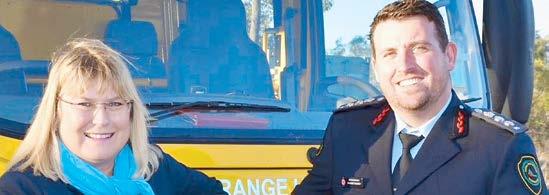
Empowering Councils Bill include:
· re-empowering councillors to appoint senior council staff, giving them a say in senior, strategic appointments to the council,
· clarifying the powers of the mayor and other councillors to provide certainty about their responsibilities,
· removing conduct breaches from the councillor conduct framework and streamlining training requirements, so councillors can focus delivering for their communities,
· allowing election candidates to include con-
tact information other than their residential address, protecting the privacy and safety of participants, and
· making the conflict-of-interest framework clearer and more straightforward, to remove red tape from councillors without sacrificing integrity in government.
The Empowering Councils Bill will do this by amending the Local Government Act 2009, City of Brisbane Act 2010, Local Government Electoral Act 2011, Local Government Regulation 2012, City of
Brisbane Regulation 2012 and Disaster Management Regulation 2014.
The Government has also signed an Accord with Queensland’s Indigenous Leaders, in the next step in enacting the Equal Partners in Government Agreement and delivering a fresh start for Queensland as promised.
The Accord mirrors the Rural and Remote Councils Compact and is another way the Crisafulli Government is working with councils to deliver on water, sewerage, infrastructure and jobs.
The Western Australian Government has taken the next step in implementing its reforms aimed at strengthening integrityandstampingoutdysfunctionacrossWesternAustralia’slocalgovernmentsector.
Local Government Minister Hannah Beazley said the government had opened applications for suitable candidates for the newly established positions of Principal Adjudicator and Deputy Adjudicators.
“The Cook Labor Government’s significant local government reforms will ensure greater accountability and improved governance in the sector.
“The role of an adjudicator is crucial as they determine allegations of conduct breaches and can impose sanctions which have been strengthened under the reforms.
“The new Local Government Inspector’s power to refer conduct breach complaints to the adjudicators is one of the tools available to strengthen sector governance and deal with dysfunction, and complements the Inspector’s focus on early intervention to resolve issues before they escalate.
“I encourage suitably qualified legal practitioners to apply for these roles and play a key part in rolling out these landmark reforms.”
Appointed by the Local Government Minister, adjudicators will replace the current Local Government Standards Panel and will be
responsible for determining alleged breaches of the Code of Conduct by mayors, presidents, councillors and committee members.
These breaches could include misuse of council resources or a council member using their office to disadvantage others.
Under the new framework, the Local Government Inspector will refer conduct breach complaints to the adjudicators.
The Inspector will be supported by a team of skilled investigators and compliance specialists who will collectively drive greater accountability, improved decision-making and enhanced
transparency across all Western Australian local governments.
Adjudicators will have the authority to make findings, order mediation or impose sanctions. Sanctions could include suspending payment of allowances, suspension from a committee, or suspension from council for up to three months. Applications are now open to legal practitioners with at least five years’ experience, who can apply via the following: www.dlgsc.wa.gov.au.
Rural, regional and remote Councils in NSW are unilaterally opposed to the Federal Government’s proposal for a blanketed30kilometreperhourreductionofdefaultspeedlimitsoutsidebuilt-upareas,accordingtoCountryMayors AssociationofNSW(CMA)Chairman,MayorRickFirmanOAM.
Submissions are currently being received and will inform a final Regulatory Impact Analysis about proposed changes to the Australian Road Rules.
“Fortunately, the State Governments set their road rules and the Federal Government’s recommendations are just that,” Mayor Firman said.
“Speed kills and like the Australian Government, we acknowledge that. The desire to reduce deaths and injuries on our roads is something we all share.
“However, the proposal to reduce the ‘default’ speed limit from 100km/hr to as little as 70km/hr and the application of a lower speed limit for unsealed roads is beyond excessive and lacks genuine consideration for key concerns for those who actually drive the roads where default speed limits apply.
“Additionally, the data cited by the Government is broad and does not specifically refer to
unposted or unsealed roads.”
Another major cause of motoring deaths is driver fatigue. The CMA Board and Members expect that speed limits reduced by as much as has been proposed could increase incidents of driver fatigue because trip duration would be longer.
“Lowering default speed limits will obviously increase travel times, exacerbating the tyranny of distance issues that impact on those living in smaller towns and villages, increasing their sense of isolation,” the chairman said.
“This undermines efforts to promote regional liveability and population growth. They’re talking about increasing the travel time to medical attention by 20-30 percent. That could have critical, even life-threatening outcomes and impact quality of life, with rural residents likely to reconsider some medical appointments when facing such as increase to the travel time.”
Road freight is another common area of concern. Slower travel speeds will increase costs for producers and freight operators, reduce supply chain efficiency, and potentially raise prices for consumers.
The NSW Freight Data Hub shows that freight productivity is directly linked to travel time reliability and road condition.
“The consequences of a significantly lower default speed limit would be renewed pressure on truck driver to drive for longer and a greater push for increased truck tonnage allowances, resulting in negative impacts on the road conditions,” he said.
“Our CMA communities do not accept that the current standard of our roads is all we can expect or deserve. A lowering of the default speed limit would suggest that the Australian Government thinks otherwise.”
“Our CMA members have advised that the
extent of the proposed speed reduction, absence of any consideration of the need for improved rural road infrastructure funding, risks undermining community confidence in the legitimacy of speed management proposals. There are concerns that policing resources would be over-burdened because few in remote areas would respect such as excessive speed reduction. A one-size-fits-all approach to default speed limits for rural roads could be seen as so ridiculous by road users that Country Mayors anticipates low compliance expectations.”
The mayor however said he had been encouraged by talks with NSW Minister for Roads and Regional Transport Jenny Aitchison.
“She has assured us that this is just one part of the process and the NSW Government will genuinely consult with Councils and communities before any change to NSW road rules are considered,” he said.
TheMunicipalAssociationofVictoria(MAV)hashonouredandcelebratedtheexceptionaldedicationandunwavering
Presented on 9 October, the service awards recognise the dedication of councillors to their communities and the broader local government sector.
MAV President Cr Jennifer Anderson said every councillor to receive an award should stand proud of their leadership and commitment to enhancing the quality of life for all residents. “Being a councillor is a demanding role. It’s one undertaken with a deep sense of community, particularly when serving over a significant length of time,” Cr Anderson said.
“It’s also often completed as a second job or alongside caring for family.
“Acknowledging these milestones is vital. The role of a councillor can be demanding and often thankless, particularly as the expectations of our communities continue to change but their service is the foundation of local democracy.”
“The MAV, and the sector, extends its deepest thanks to these councillors for their commitment to local government. They have each left an indelible mark on communities across the state,” Cr Anderson said.
10-YEAR SERVICE AWARD Mayor Cr Lisa Cooper – Knox City Council Cr Lawrie Cox –Whittlesea City Council and formerly Shire of Whittlesea Cr Sally Davis – Stonnington City Council Mayor Cr Irene Grant – Wangaratta Rural City Council Mayor Cr Rochelle Halstead – Bass Coast Shire Council and formerly Frankston City Council Mayor Cr Grace La Vella – Central Goldfields Shire Council and formerly Manningham City Council Cr Eric Lording – Murrindindi Shire Council.

15-YEAR SERVICE AWARD Cr Paul MacDonald – Maroondah City Council and formerly City of Croydon Cr Peter Perkins – Nillumbik City Council
20-YEAR SERVICE AWARD Mayor Cr Jim Memeti – Greater Dandenong City Council Cr
The Municipal Association of Victoria (MAV) has called for comprehensive parliamentary scrutiny of the State Government’s planning reform bill introduced in late October raising concerns for the councils responsible for administeringVictoria’splanningsystem.
MAV President Cr Jennifer Anderson said Victoria’s 79 councils have not been consulted on legislation that will dictate how our communities are shaped now and into the future.
“Local Government has not been consulted on this Bill. Instead of consulting the council planners whose job it will be to make the new provisions work, the State Government has chosen to impose those new provisions without testing them,” Cr Anderson said.
“The Bill aims for faster decisions and greater certainty, but the closed-shop approach to reform risks inefficiency and mistakes. Ultimately, it risks the erosion of public trust in planning decisions and in government.”
“Councils strongly support making Victoria’s planning system more efficient and effective across metro Melbourne and throughout rural and regional Victoria.”
According to MAV data, Victoria already has more than 100,000 dwellings approved by councils that remain unbuilt; not due to council blocking, but rather as a result of unfavourable market forces.
The MAV is concerned that several critical issues won’t be addressed and will require parliamentary attention.
“Sixty activity centres are being rezoned for higher density development without any
requirement for affordable homes. This precedent highlights the MAV’s concerns that this Bill will fail to address the real problem of housing affordability across the rest of Victoria.”
“This is a once-in-a-generation opportunity to shape Victoria’s future, and we need to ensure we get it right,” Cr Anderson said.
The MAV is also concerned proposals to wind back notice provisions would remove a critical quality control mechanism, with local communities often providing important local knowledge.
“We’re calling for state and local governments to pull together as genuine partners, to
ensure housing happens faster, better, and –most importantly – with community support,” Cr Anderson said.
MAV CEO Kelly Grigsby said speed cannot come at the expense of quality and safety.
“We can’t afford to compromise on climate resilience when one in four regional properties is projected to be uninsurable by 2030. Victorians need homes that can withstand floods, fires and extreme heat - not just fast approvals,” Ms Grigsby said.
Ms Grigsby said the MAV is not asking to slow housing down, but to ensure proper consultation and partnership structures.


Smart local councils around Australia have discovered the next generation of road and path surfaces. Made with crumb rubber from recycled tyres, they are safer, cost effective and more resilient than ever before.
Ready to discover the crumb rubber difference?
SpendingafewdaysinDubailastmonth,Imarveledattheworld’sbiggestshoppingmall-1,124,000sq.m.orfivetimes thesizeofourbiggest,ChadstoneMall.NextdoorisBurjKhalifa,theworld’stallestbuildingat828metres.Meanwhile DubaiAirportisexpectedtosoonovertakeAtlantaastheworld’sbusiest.

The city’s population has doubled in 15 years to four million - it is basically a huge construction site. Low energy prices and low labour costs underpin the economic growth. For example, UAE energy users pay less than half that of their Australian equivalents, mainly due to a complicated gas reservation program for the domestic market. And unskilled labour costs are about a quarter of those in Australia. As a result, the UAE now has very significant capability in aluminium, steel and metal fabrication.
Landing back in Oz, the big news was the imminent closure of Rio Tinto’s Tomago aluminium smelter (Australia’s largest) together with updates on the approval of gas drilling adjacent to the Great Ocean Road. Both matters are a testament to the unwillingness of Australian governments to restrict gas exports.
Rod Campbell, Research Director at The Australia Institute, has been a constant critic of our energy policy. He argues that Tomago’s problems stem from the fact that its energy source is gas-fired electricity, the cost of which has gone through the roof as our gas exports have progressively climbed. Campbell also notes that little to no royalty payments are in place for these exports.
Rio Tinto’s Tomago smelter’s problem reportedly stems from its inability to source competitively-priced renewables energy, whereas its other smelter - at Boyne Island (Gladstone) - is further down the transition to renewables road. It would be lamentable if the federal and state governments bail-out the Tomago smelter. It would be a band aid solution. The need surely is to acknowledge that gas has a place in our economy’s transition to renewables, and that some level of gas exports - both current and future - must be diverted to the domestic market. The feds need to loosen up its longstanding position that modifying energy contracts with foreign multinationals would damage our international reputation.
I have a strong feeling that the refusal of the federal government to act on this is due to the energy and manufacturing industry responsibilities now residing within the same portfolio - the Department of Industry, Science & Resources. To explain, Australian manufacturers are crippled by high energy costs and are thus lobbying the feds for greater gas supplies into the domestic market. Their concerns are going nowhere arguably because DISR is conflicted and thus keeping out of the debate. The key point is that the Westminster system is based around Cabinet ministers from different fields thrashing out issues. In the past, a strong industry minister like John Button would probably have won a Cabinet stoush with the resources minister. There are hundreds of manufacturing and minerals processing companies in the same bind as the Tomago smelter. Our comparative advantage in energy is simply not translating into a competitive advantage. Councils with a strong manufacturing presence are encouraged to keep engaged on this issue.
Small offerings of local produce – a lesson from Crete
We’d finished a heavy meal on the Greek island of Crete last month. The waiter was a friendly character who gave a spiel on the island and reminded us about Melbourne being the city with the largest Greek population outside of Greece. He explained that Crete ‘goes to sleep’ in late November when the tourists depart. While the Cretan economy is overwhelmingly tourism-based, agriculture is also a good contributor by virtue of cheese, wine and spirits, honey, raisins, fruit and vegetables. Anyway, my new best friend then arrived at
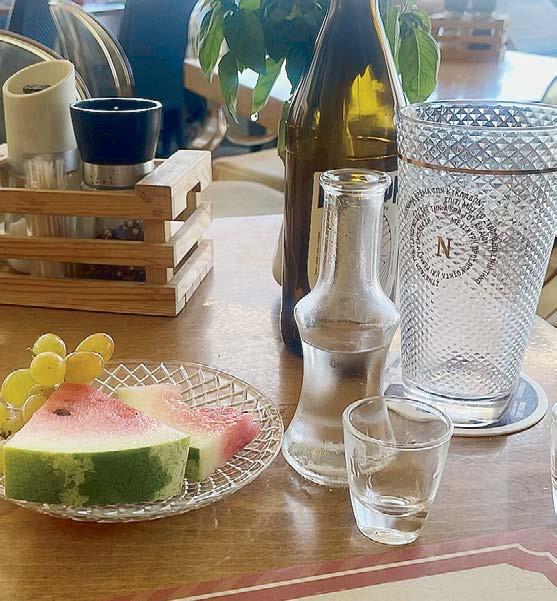
the end of the meal with slices of watermelon and a small glass of tsipouro, the local spirit. The watermelon was refreshing, and the tsipouro was a nice touch.
The waiter explained that this was a custom in Crete and other parts of Greece – a small memento of appreciation. Sometimes it’s a small bunch of grapes when in season, or a small bowl of local yoghurt. He uses his judgement on to whom he offers the tsiporou.
I’d love for this custom to become popular in Australia. Why? Well, many small country towns need a WOW factor to bring travellers off the highway. Something that sticks in the mind and will lead to return business. The offering should wherever possible be local produce. Perhaps slices of apple or pear, or an Aussie equivalent of tsiporou.
In this regard, a few years back I was undertaking food cluster work for the City of Playford when I stumbled on an Adelaide company producing limoncello from Riverland lemons. These days there is Ambra Spirits, and it serves it in shot glasses free to restaurant clientele. If restaurants or pubs in your LGA are interested in the idea, tell them to contact Finn at Ambra - the ballpark cost is $360 for a case of twelve bottles. Similarly, a nip of Bundaberg Rum could be offered in restaurants in the Wide Bay-Burnett
region, given that company is a local institution. Or apple cider in Tasmania, or say the Dandenong Ranges. Or in WA there is Sin Gin producing wonderful sloe gin from the berries of blackthorn bushes grown in Tasmania. The company also produces limoncello from lemons grown around Gingin north of Perth - around $300 for six 500ml bottles.
The key point is that a small offering of local produce can be a great incentive for return business. A restaurant bill of $80 for two is commonplace these days – and $3-4 worth of liqueur and/or fruit will have patrons filing away the experience.
The Albanese Government is to soon announce details of a sell-off of Defence land to assist with the delivery of housing supply. A report on the issue has been with the Government for some time. Notwithstanding resistance from the Defence Department, Housing Minister Clare O’Neil and Treasurer Jim Chalmers won the day. Interestingly, O’Neil’s ministry sits within Treasury! She is a rising star – strong CV and good media skills.
I had flagged the Defence sell-off in April 2023 in this column when discussing land supply options, as follows:
‘Another opportunity might lie in Defence
land sales. Although Defence has had a land sell-off in recent times, the Department of Finance would now be arguing for more. Perhaps I’m dreaming, but Defence has facilities on prime urban land that are an accident of history. Think about HMAS Penguin (14 hectares) near Taronga Zoo and Watsonia Barracks (55 hectares) in Melbourne’s northern suburbs. These facilities could arguably be moved to regional areas, and the sites turned over to medium density housing with parklands.’
Local councils should track this issue and get directly involved where possible. One scenario is for councils to lead the process of land remediation and rezoning of the former Defence sites.
The second scenario is for councils to (i) identify sites for the relocating Defence facilities, (ii) pitch these sites to the Defence Minister, and (iii) commission work to identify activities that could be co-located with these Defence facilities viz. defence equipment, research laboratories, logistics hubs, cybersecurity etc.
Please email us if you’d like to pursue these opportunities.
Rod Brown is a Canberra-based lobbyist specialising in industry/regional development. Email apdcockatoo@iprimus.com.au


Australia,councilteamsarebeingaskedtodomorewithless.
With increasing governance requirements and growing community expectations, even the most capable councils are finding it harder to stay on top of grants, projects, and reporting. What used to be simple tracking has become a complex web of spreadsheets, shared drives, and email trails.
For many, it’s not the ideas or intent that hold projects back, it’s the process. When funding applications are pieced together across multiple systems, duplication and errors creep in. Lessons learned in one department rarely reach another, and compliance checks happen too late in the cycle to prevent problems. It’s a familiar story: hardworking teams, strong projects,
missed opportunities.
But a quiet shift is underway. A growing number of councils are moving from reactive administration to proactive strategy, putting systems in place that make good governance second nature. By centralising grant and project management, they’re gaining real-time visibility, ensuring audit readiness year-round, and freeing staff to focus on outcomes instead of paperwork.
“We’ve seen it countless times. One secure system changes everything,” SurePact CEO Dan Pritchard said.
“It streamlines the process, strengthens transparency, and lets teams focus where they make the most impact.”
The benefits are tangible. Centralised data eliminates duplication. Built-in workflows standardise governance across departments. Dashboards turn raw information into insight, helping councils tell a clearer story about where funding goes and what it achieves.
For CEOs and finance leaders, the value goes beyond efficiency. Reliable reporting builds credibility with funding bodies, councillors, and ratepayers alike. When compliance and transparency are visible, trust follows and that trust is increasingly vital in today’s competitive funding environment.
Digital platforms such as SurePact are helping councils lead this change. Australian owned
and built for local councils, SurePact brings every stage of the grant lifecycle into one easyto-use platform. For councils, it means fewer spreadsheets, fewer risks, and far less time spent chasing documentation. Compliance becomes automatic, not an afterthought.
As the funding landscape tightens, forwardthinking councils aren’t waiting for the next audit to act. They’re optimising their processes now, ensuring that when opportunities arise, they’re ready: organised, compliant, and confident.
To learn more about how councils are using SurePact to streamline their grant management visit SurePact.com.
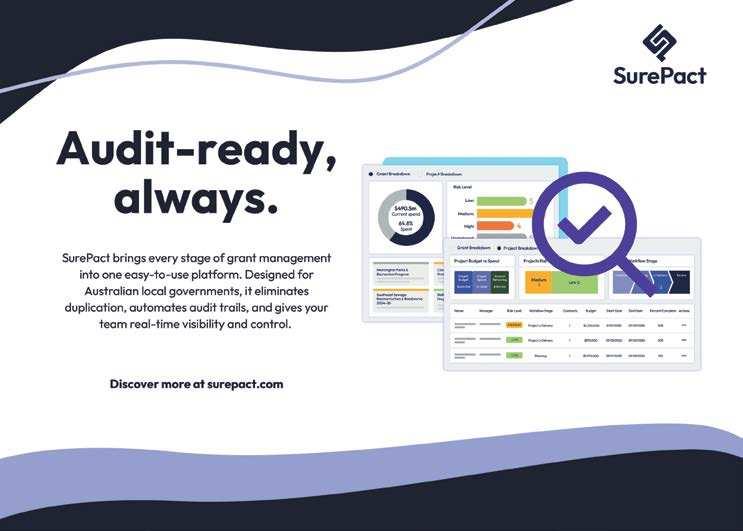
GriffithCityCouncilhaselectedCouncillorScottGroatasthenewDeputyMayoratthe OrdinaryCouncilMeetingheldonTuesday,28October2025.
Cr Groat will hold the position for the next 12 months, supporting Mayor Doug Curran in representing the Griffith community and providing leadership to Council.
Mayor Doug Curran congratulated Cr Groat on his appointment and welcomed the opportunity to work closely together.
“I’d like to congratulate Cr Groat on being elected Deputy Mayor,” he said.
“It’s a great opportunity to step into a leadership role and help shape the direction of our city. I’m looking forward to working alongside him over the next year as we continue to deliver for the community,” Mayor Curran said.
“I’d also like to thank Cr Napoli for serving as Deputy Mayor over the past three years. Her commitment to representing the interests of our community and supporting the work of Council has been greatly appreciated.”
The election of the Deputy Mayor is held annually in accordance with the Local Government Act 1993. The Deputy Mayor acts in the Mayor’s role as requested during any absence and assists in undertaking key civic and leadership responsibilities.
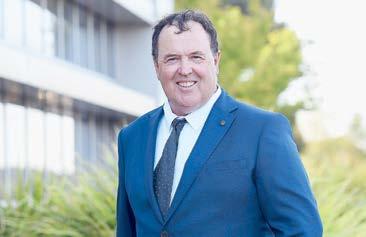
CouncillorScottGroat.
BarungaWestCouncilChiefExecutiveOfficerMareeWauchopehasfinishedupher five-yearroleatthecouncilattheendofOctober.
According to the council her tenure marked a successful period of record capital investment, strengthened governance, and financial sustainability.
Since her appointment in April 2020, Ms Wauchope has overseen the delivery of more than $40 million in public and private infrastructure in what has been the largest investment program in the Council’s history.
Thecouncilreleasesaidtheregionhadbeen transformed through major projects including the Fisherman Bay Freeholding Project, Port Broughton Civic Square redevelopment, Bute Soldiers’ Memorial Hall restoration, and residential and industrial land developments.
Under Ms Wauchope’s leadership, Barunga West Council has evolved from financial constraint to stability and growth, increasing its asset base from $53 million to $81.17 million and achieving a 40 per cent rise in rate revenue.
As of September 2025, Barunga West has seen an increase of 151 new ratepayers, bringing the total number to 2,868.
This marks a 5.56 per cent growth since September 2019, reflecting the appeal of the region and the continued progress made under Council’s leadership.
“In2020Councilwasfinanciallyconstrained and carrying years of asset backlog. By 2025, it is financially strong, modern, and communitydriven in what has become a benchmark for regional council performance,” Ms Wauchope said.

BarungaWestCouncilChiefExecutive OfficerMareeWauchope.
“The organisation is now characterised by stability, capable leadership, and a culture committed to service and outcomes for its community.
“Barunga West now stands on a foundation of stability and momentum that will continue well into the future. I am immensely proud to leave it in its strongest position in decades.”
During her tenure, Council also unified its tourism identity under the Top of the Yorke brand, established new community facilities such as all-inclusive playgrounds, and led award-winning initiatives including the Bute Silo Art Project and the Port Broughton Civic Square.
Port Broughton was named South Australia’s Tiny Tourism Town of the Year in 2023.
Ms Wauchope credited Council’s strong
relationship between elected members and administration as key to achieving these outcomes.
“This period has been marked by stability and integrity at both governance and administrative levels,” she said.
“Together we’ve delivered record investment and built a culture of professionalism and accountability that will benefit the community well into the future.”
During her leadership, Barunga West Council secured more than $7.7 million in State and Federal grants, modernised its policies and governance systems, and implemented transparent financial reporting and performancebased management frameworks.
Mayor Leonie Kerley said Ms Wauchope’s leadership had transformed the Council into one of regional South Australia’s most respected local governments.
“Maree has delivered stability, direction, and a clear sense of purpose for our organisation and community,” Mayor Kerley said.
“Her leadership has positioned Barunga West for continued success and growth.”
Ms Wauchope’s tenure formally concluded on 31 October 2025, with Council well advanced in the process of appointing a new Chief Executive Officer.
She starts a new role as Executive Director of Property Services with the SA Housing Trust.
BassCoastShireCouncilisproudtocelebrateMayorCrRochelleHalstead,hasbeen recognised with a 10-Year Service Award from the Municipal Association of Victoria (MAV).
The honour acknowledges her decade of dedicated service to local government and her enduring commitment to the communities she has represented.
Cr Halstead’s career in local government spans many years and reflects her strong sense of civic duty, leadership and community connection. Her public service journey began with her election to Frankston City Council in 2003, where she also served as Mayor.
Since being elected to Bass Coast Shire Council in 2020, Cr Halstead has represented the Westernport Ward with passion and integrity. She served as Deputy Mayor in both 2023 and 2024, before being re-elected at the 2024 local
government election for a further four-year term.
A graduate of the Australian Institute of Company Directors, Cr Halstead brings a strong understanding of governance, transparency and accountability to her role. Her leadership is defined by enthusiasm, openness and a resultsdriven approach, with a deep commitment to ensuring every voice in the community is heard.
In addition to her role as Mayor, Cr Halstead waselectedearlierthisyearastheRegionalBoard Director for the MAV representing Gippsland, where she continues to advocate strongly for the needs of regional and rural councils.
Reflecting on the milestone, Mayor Halstead said her greatest motivation has always been the

HobsonsBayMayor, CrDariaKellander,has announcedexperienced localgovernment executivePhuNguyen asthecouncil’snew chiefexecutiveofficer.
Currently the CEO of the City of Onkaparinga in South Australia, Mr Nguyen grew up in Melbourne’s western suburbs and will return to the west when he takes up the position on 19 January 2026.
Mr Nguyen has had a broad career across Victoria, New South Wales and South Australia.
He was the chief financial officer at the City of Melbourne and the deputy general manager (deputy CEO) and director city governance at Campbelltown City Council in outer Sydney.
He has been the CEO at the City of Onkaparinga, the largest council by population in South Australia, since 2023.
The council has 800 FTE staff and a $240 million operating budget. At Onkaparinga, he has led significant cultural and performance change, including the development of a new Community Vision and organisational values framework, and returning the council to surplus after seven years of consecutive deficits.
Cr Kellander said Mr Nguyen stood out significantly in a strong field of candidates for the role, particularly against the priority key success factors around governance and culture.
“The CEO Employment Matters Committee structured its selection process around the specific context in which Council is working at the moment, which includes an identified need to rebuild its governance, culture and brand while refocussing on service delivery and longerterm strategic priorities,” Cr Kellander said.
“Mr Nguyen is a very experienced executive who grew up in Melbourne’s west and understands the issues facing the region. Council is very excited about Mr Nguyen’s appointment, and we look forward to welcoming him back to the west and working with him to build a bright future for Council and the community.”
Mr Nguyen said he was “thrilled to join Hobsons Bay as the new CEO”.
people she serves.
“Representing this community is both an honour and a privilege. Every conversation, every project, every decision is about making Bass Coast an even better place to live, work and visit. I’m constantly inspired by the passion and care our residents have for this region, and it’s what drives me every day to do my very best on their behalf.”
Bass Coast Shire Council congratulates Cr Halstead on this well-deserved recognition. Her leadership, passion and long-standing dedication to local government continue to make a lasting and positive difference to the Bass Coast community.
“I have been given a clear mandate from Council to focus on building a highperforming team culture and supporting staff while rebuilding corporate governance,” he said.
“I am excited to return to Melbourne’s vibrant west and to work alongside staff on building a proud organisation that will be known for delivering exceptional community outcomes, financial resilience and a great organisational culture.”
The CEO search and selection process was managed under the terms of the CEO Employment and Remuneration Policy 2025 guided by the CEO Employment Matters Committee on which all Councillors were represented.



Custom-designedelectricgatesarehelpingpeoplewhousemobilityaids,likewheelchairs andscooters,toenjoyanaturereserve,andeasieraccesstoaneighbourhoodshopping area.
In a WA-first, people with disability can now register with the City of Cockburn to receive a remote-control fob that controls two gates at Little Rush Lake in Yangebup.
The remote control opens and closes the electric gates, wide enough to accommodate wheelchairs, on the western and eastern sides of Samuel Caporn Reserve. The fobs are kept by each registered holder until no longer required and returned to the City.
The gates also provide access to a shopping centre in South Lake, east of Little Rush Lake on North Lake Road. Access via nearby Osprey Drive is not possible due to the lack of a shared path.
The bushland reserve, like many in the Perth metropolitan area, is fenced with entry points restricted by chicane safety barriers designed to keep motorbikes out of the fragile environmental and protect the safety of pedestrians.
The barriers stop illegal motorbike riding but also prevent people who use wheelchairs and other mobility devices from entering the public reserve.
City of Cockburn Disability Access and Inclusion Officer Jennifer Crowther said the City had acted on feedback from people with disability who were unable to access the reserve, or the adjacent shopping centre.
“The City’s Environmental Operations team took about six months to create a design which was then assessed by consultants before funding was sourced to allow production,” Ms Crowther said.
“We installed the gates in June 2025 and after some testing and teething problems, the antenna were upgraded to provide a more efficient remote signal to activate the gates.
“The project took more than two years to develop and we hope it can be a model easily adapted by other local government areas.
“The City will explore potential future gate locations to support this important initiative.”
Hamilton Hill resident and keen bushwalker Joel Raykos and his Support Worker Kathrin

Ploetz said Little Rush Lake was now on their ‘must visit’ list.
Joel, who communicates with the aid of an augmentative and alternative communication (AAC) device said he loved regular walks, with Manning Park in Hamilton Hill among his favourites.
Kathrin, who has been Joel’s support worker for 22 years, said Joel had always been a keen walker and was excited to learn about a new accessible Cockburn reserve to explore.
His mum Gina Raykos said her son and Kathrin enjoyed regular walks in parks and along coastal paths and had previously experienced bollards that stopped Joel and his wheelchair
accessing public recreation areas.
Joel said the bollards also stopped people using other mobility devices, such as mobility scooters like Gophers, and even prams, from visiting public parks.
The gates’ installation helps fulfil the City’s 2023-2028 Disability Access and Inclusion Plan (DAIP), the fourth of its kind to be adopted by the City since the first was implemented in 2007.
The DAIP encompasses six outcomes that focus on providing accessible services, information, buildings, customer service, complaint channels and public consultation, while expanding the City’s current employment and training pathways for people with disability.
Renowned creatives, Gillian Kayrooz and L-FRESH The LION have been appointed as theleadartistsforthe$1millionreVITALise-PublicTransportPrecinctVibrancyGrant program,whichwillimprovepeople’sexperiencebetweenCampbelltownStationtothe heartofCampbelltownCityCentre.
Campbelltown City Council have partnered with Transport for NSW on this exciting initiative, with the focus on transforming the Hurley Street Underpass and its surrounding areas into a more vibrant, safer and well-connected space.
L-FRESH is a globally recognised hip-hop artist who grew up in South-Western Sydney and uses his platform to highlight cultural identity, social justice and elevate diverse voices from Western Sydney. He is deeply connected to Campbelltown and is the founder and Artistic Director of Campbelltown Arts Centre’s program Conscious, a hip-hop artist career development program.
Gillian Kayrooz is a respected Western Sydney artist whose vibrant, contemporary works explore identity, culture and community through dynamic visual storytelling. Her practice is grounded in lived experience and sustained by deep connections with local communities, reflecting a commitment to collaborative approaches to storytelling.
Through community engagement held earlier in the year, we heard that priorities such as public art, creative lighting, clearer wayfinding, enhanced safety measures and improved maintenance and cleanliness were important to the community.
Building on from this feedback, the artists will work closely with the community over the coming weeks to explore these priorities and shape the final art installation design.
“It’s fantastic to have two talented, local artists like L-FRESH and Gillian Kayrooz, who can contribute their creativity to this exciting project

and I look forward to seeing how their work will enhance the space for the community,” Mayor of Campbelltown, Darcy Lound said.
“The improvements will support vital works to strengthen the connection from Campbelltown Station to Queen Street and enhance amenities, safety features and overall accessibility, creating a more welcoming environment for commuters and visitors alike,” Cr Lound said.
“This is a fantastic project that will bring our community closer together and really bring our fantastic public transport hub to life,” said Mr. Greg Warren, Member for Campbelltown, Parliamentary Secretary to the Deputy Premier, Parliamentary Secretary for Education and Early Learning, and Parliamentary Secretary for Western Sydney.
“Working with artists like L-FRESH the LION and Gillian Kayrooz who have roots in Campbelltown and Western Sydney more broadly is
ShellharbourCity Council’sArtin UnexpectedPlaces programcontinues tosurpriseand delight,withthelatest installationfeaturingthe vibrant,layeredworks ofSouthCoastartist DarrenKing.
Known for his bold mixed media collages, Darren brings a fresh perspective to public spaces, transforming everyday infrastructure into joyful, nostalgic artworks. His creations will be featured on bus shelters throughout Shellharbour, continuing the program’s mission to bring creativity into everyday spaces.
Shellharbour City Mayor Chris Homer said the program supports local artists while making public spaces more vibrant and welcoming.
“We’re proud to support local artists and make art accessible to everyone. Darren’s work is rich in texture and meaning, and it reflects the creativity and character of our region,” Mayor Homer said.
A multidisciplinary artist trained in fine arts, cartooning, illustration, graphic design, and screen printing, Darren has exhibited widely and earned recognition through national and international art prizes.
He prides himself on working primarily with recycled and repurposed materials, including discarded magazines, junk mail, maps, paper bags, and vintage books.
“I love turning the overlooked into something memorable. Art doesn’t have to be confined to galleries. It can live in the streets, on a bus shelter, or anywhere people least expect it,” Darren said.
outstanding and will help bring the spirit of our area to the fore,” Mr Warren said.
“The reVITALise Grant program aims to make journeys safer, seamless, and more connected, and Transport for NSW is proud to partner with Campbelltown City Council on this exciting project. The Council’s project highlights the vital role public art and community collaboration play in strengthening perceptions of safety and community identity, to create more connected and vibrant transport hub precincts,” said Brooke Wharton, Transport for NSW A/Executive Director Active Transport and Vibrancy.
“Campbelltown has shaped who I am. It’s where I grew up, had my first performances, and built lifelong connections. To now contribute creatively to a project that will reimagine this space for the community feels like a full circle moment, and I’m proud to help bring our stories and spirit to life here,” said L-FRESH The LION.
“My practice has been deeply shaped and supported by the communities of Western Sydney, giving me a deep appreciation for the power of community and storytelling. I’m honoured to work with L-FRESH and the people of Campbelltown to create something that reflects their stories and spirit, and contributes to a vibrant future for the community, grounded in creativity and resilience,” said Gillian Kayrooz.
Campbelltown is one of seven councils benefiting from Transport’s $7 million reVITALise – Public Transport Precinct Vibrancy Grant program, receiving $1 million to design and deliver community-informed placemaking and vibrancy initiatives in public transport precincts.

NorthQueensland’senviableoutdoorlifestylewillnowbeeasiertoenjoywithTownsvillecouncillorsvotingtocutred tapeandendorseapolicythatencouragesfootpathdiningandshoppingacrossTheStrandandcitycentre.
Townsville City Council’s new Outdoor Dining and Footpath Activation Policy – passed unanimously at the 15 October Ordinary Meeting – revokes the need for a specific permit, and information about insurance coverage, for most businesses seeking to undertake footpath trade across the city.
The policy instead provides a general statement of permission for outdoor dining to hospitality operators across the city that meet general, easy-to-achieve requirements.
Free and streamlined processes remain in place – after originally being introduced in 2023 – for those businesses that do not meet the general requirements, with Council committed to assessing applications from outlying operators on a case-by-case basis.
For the first time the new policy will also encompass retailers, with Council encouraging shop owners – particularly in the city centre – to place their goods on footpaths to generate interest and enliven the street.
Acting Townsville Mayor Councillor AnnMaree Greaney said Council was committed to enriching the city centre and enhancing The Strand’s already enviable reputation as a lifestyle destination for locals and visitors alike.
Councillor Greaney said Council had keenly taken onboard the advice of renowned placemaker and urban planner David Engwicht who, on the invitation of the local business-led Uptown Group and Council, visited in March and again in June to assess and advise on opportunities to revamp the city centre.
TheCityofGreaterBendigohasdecidedtopauseplans foranextended12-monthe-scootertrialasthesector preparesforsignificantlegislativeandindustrychanges affectingsharehireschemesacrossVictoria.
Earlier this year, Council approved a 12-month trial extension to expand e-scooter operations in urban Bendigo. Beam Mobility (Beam) participated in the initial 12-month trial launched in May 2024, which aimed to improve connections between urban precincts and encourage more sustainable transport choices for short trips.
Beam’s contract was extended temporarily this year after the trial ended to provide a service while the City undertook a procurement process for the second 12-month trial. Beam has chosen not to apply for the next contract process beyond the temporary extension.
The micro-mobility share hire industry is currently undergoing considerable change, with new Victorian Government safety technologies and regulatory requirements expected in late 2025. These include a pre-approval scheme for operators, with requirements such as helmet compliance, cognitive testing, Bluetooth Beacon technology for designated parking, and footpath detection technology.
While a few of these requirements may not be mandatory for regional areas, the City’s preference is to better understand the changing requirements in the first instance.
Manager Strategic Planning Anthony Petherbridge said it was the right decision to pause the trial with so much uncertainty in the industry.
“During the procurement process, it became clear that the industry is navigating a period of transition, with operators preparing for new Victorian Government pre-approval requirements expected later this year,” Mr Petherbridge said.
“To ensure any future trial is successful and aligns with best practice, the City has decided to pause the process while these changes take effect. Over the next six months, we will undertake a market analysis and consider renewed procurement options once the new regulatory
framework is established at state level. We remain open to new and innovative opportunities for share hire schemes in the future.
“If a future trial proceeds, we will place greater emphasis on the inclusion of e-bikes and only consider the Department of Transport and Planning’s pre-approved operators to ensure factors around community safety and compliance.
“The purpose of the trial has always been to provide residents and visitors with a sustainable, affordable, and convenient alternative mode of transport. We are grateful for the lessons learned from the initial trial, which informed recommendations for expanding the scheme to areas such as Golden Square, Long Gully, and White Hills, in line with our shared walking and cycling networks.
“The City would like to take this opportunity to thank Beam for its partnership in delivering the region’s first e-scooter share hire scheme and for its strong collaboration with City officers and community stakeholders. The trial in a small area of urban Bendigo demonstrated the potential for e-scooters to offer an alternative transport option for the community.”
Beam Mobility Chief of Staff Ross Vinten said since the launch in May 2024, riders have travelled nearly 90,000 kilometres, close to 55,000 trips.
“While the program has been well-received, ridership has been lower than expected and continuing the service is unfortunately not financially viable for us. We sincerely thank the City of Greater Bendigo, our loyal riders, and local businesses for their support, and our dedicated local Beam team for keeping the service running safely and reliably,” Mr Vinten said.
Beam’s temporary operations in urban Bendigo ended Thursday 23 October. Beam has notified its e-scooter riders via the Beam app.

During his visit, Mr Engwicht recommended the use of permission statements to allow city traders to trade on their footpaths in a bid to create points of interest and activate the precinct.
“As Mr Engwicht pointed out, our city centre has ‘very good bones’ and there are so many steps we can take – some small and simple such as this one – to really enhance and enliven the area,” Cr Greaney said.
“We have city centre traders already doing a wonderful job of making the most of their footpaths, Gecko Interiors being a stand-out example.
“Under this new policy, we are inviting and encouraging more of that.”
Councillor Greaney said hospitality venues on the Strand were being encouraged to explore
options for outdoor dining, as provided by the new policy.
“Council is committed to approving the use of the Strand foreshore for outdoor dining in a way that balances community expectations for other uses of the space and is not detrimental to the amenity of The Strand,” Cr Greaney said.
“We have had some learnings in this space over the past 18 months and we are pleased that, now this new policy has been written and adopted, we can ensure we get that balance right.”
The Council’s new Outdoor Dining and Footpath Activation Policy will replace the existing Outdoor Dining Policy.
It will be reviewed in four years’ time.
WarrumbungleShireCouncil,incollaboration withitsHeritageAdvisorandlocalheritageand communitygroupsfromBinnaway,Baradine,Coolah, Coonabarabran,Dunedoo,andMendooran,ispleased toannouncethecompletionandreleaseofsix WarrumbungleShireHeritageTrailBrochures.
Each township now has its own full-colour brochure highlighting its unique history, culture, and architecture. Inside, readers will find a brief history of the town, a detailed map showing the location of key heritage sites, and descriptions of significant buildings and landmarks.
The back of each brochure also includes a list of other local attractions to visit in the surrounding area, encouraging visitors to further explore the region.
Printed copies are now available at community venues across the Shire, including libraries, galleries, and visitor centres, with a digital interactive version to be launched soon on Council’s tourism website.
Warrumbungle Shire Council Mayor, Councillor Kathryn Rindfleish said the six brochures represent a significant step in preserving and promoting the Shire’s heritage.
“Our towns have incredible stories to tell, from early settlement and industry to the
people and places that shaped our region,” Cr Rindfleish said.
“These brochures celebrate that history while encouraging both residents and visitors to explore and appreciate the unique character of each township.”
The Heritage Trail Brochures were developed through extensive consultation and collaboration between Council, its Heritage Advisor, and local heritage groups. Information was gathered from community sources, historical archives, and site visits, verified for accuracy, and compiled into a professionally designed, accessible publication.
The project is part of Council’s ongoing commitment to celebrating and preserving local heritage while supporting tourism and community pride. Council will continue to update the brochures as new information emerges, ensuring the collection remains an accurate and valuable resource for future generations.
Aonceplainandchallengingstormwaterbasinin Bundabergwillbebroughttolifewiththousandsof nativeplants,turningitintoacleaner,greenerandlowermaintenancespace.
The project is a trial by Bundaberg Regional Council to explore more cost-effective and sustainable ways of managing stormwater infrastructure.
The Telegraph Road detention basin is currently a flat, grassy area that requires regular mowing and often holds stagnant stormwater, making it difficult to maintain and creating ideal conditions for mosquitoes.
Roads and Infrastructure (urban) portfolio spokesperson and Reef Guardian representative Cr Larine Statham-Blair said the basin would be planted out with over 16,000 natives, transforming it into a natural landscape.
“This project aims to turn a piece of infrastructure that requires regular maintenance into a self-sustaining, low-maintenance environmental asset,” she said.
“It’s a smart, future-focused way of managing stormwater that also supports biodiversity, reduces costs and enhances community spaces.
“Over time, this basin will improve in both function and beauty, creating a more attractive and eco-friendly space.”
What are the benefits of the Telegraph Road detention basin project?
· Less maintenance – once established, the basin won’t need mowing which saves time and money.
· Cleaner water – the vegetation helps filter polluted stormwater before it flows into Baldwin Swamp.
· More wildlife – the plants create a home for birds, butterflies, and pollinators.
· Cooler neighbourhood – the trees will help cool the surrounding area.
· Climate-friendly – the plants will capture carbon and boost local climate resilience.
· Natural watering – stormwater will be reused to keep the plants growing.
Funding for this project has been provided by the Australian Government to support activities identified in Council’s Reef Action Plan. Construction is scheduled to commence in late November and be completed by late December, followed by a six-month period to establish the new plantings.
Morethan100enthusiasticriderscametogethertocelebrateWABikeMonthattheMurrayRides:SkillsinMotion event,heldinDwellingupduringtheschoolholidays.
The event, delivered as part of the annual statewide celebration encouraging people of all ages and abilities to ride for fun, fitness and a healthier lifestyle, offered a day packed with learning, fun, and community spirit.
Shire President, Douglas McLarty said the event was a fantastic showcase of local enthusiasm for cycling and outdoor activity, reflecting the Shire of Murray’s commitment to supporting active, inclusive and family-friendly initiatives.
“It was great to see so many young riders gaining confidence and enjoying the freedom that comes with cycling during the school holidays,” he said.
“Events like this help foster a lifelong love of bike riding while promoting healthy, active lifestyles and community connection.”
The workshops catered for all skill levels, from first-time riders to those looking to refine their on-road and off-road techniques.
Participants took part in a mix of games, challenges and guided activities that focused on building safety, balance and confidence.
Adding to the fun, the Shire’s Youth Team hosted engaging activities, while Murray Library ran a special bike-themed Story Time session for younger children.
A free sausage sizzle capped off the day, keeping riders fuelled and smiling. This event

is proudly supported as part of WA Bike Month 2025, a Department of Transport and Major Infrastructure (DTMI) initiative supported by RAC.
The Shire of Murray acknowledges their contribution to encouraging active lifestyles, promoting cycling safety, and fostering community connection.
Cowes Primary School students brought plenty of energy and curiosity to Berninneit Cultural Centre in mid-OctoberforaspecialMeettheMayorvisitaspart oftheirCommunityWalk.
Organised by Island Ward Councillor, Cr Tracey Bell, the visit began with a warm welcome from Bass Coast Shire Mayor, Cr Rochelle Halstead, who greeted the students at the door. The group explored key community spaces in the building, including the museum and the library, before heading into the community room set up for a Council meeting.
Inside, the students were polite, interested and highly engaged, listening carefully to the Mayor and asking curious questions like, “What do you do as Mayor?” and “Do you get to help people?”,
Before heading back to school, each child received a gift pack, including native seeds to plant at home — a hands-on reminder that everyone can help care for our environment.
“It’s always inspiring to see young people so interested in how their community works,” Mayor Halstead said. “Their respectful questions and enthusiasm were fantastic — I’m sure we met some future leaders today.”
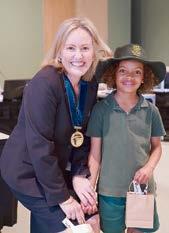
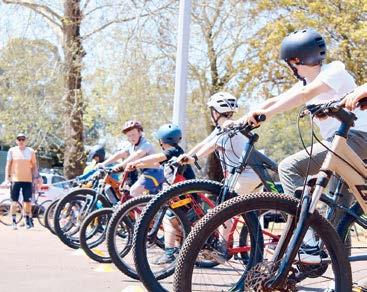
InpartnershipwiththeFriendsoftheGreatVictorian Rail Trail, Murrindindi Shire Council has recently installed five station nameboards inspired by vintage designsalongtheGreatVictorianRailTrail.
This initiative honours the region’s rich railway history and complements existing signage in neighbouring council areas and other points of interest along the trail.
Installed on 14 October by local Council contractors with support from the Friends of the Great Victorian Rail Trail, the signs feature laser-cut aluminium lettering and powder-coated steel, which closely emulate the original 1910s design of cast letters and timber backboards, honouring the historical character of the project.
Friends of the Great Victorian Rail Trail Secretary Ross Vaughan said they had a long association with the project.
“This is a project we have been involved with for over two years, beginning with Mansfield and Mitchell Shire Councils,” he said.
“This final section brings the project to completion, and we are delighted to see it realised. We thank Murrindindi Shire Council for its support and look forward to the signs reconnecting the rail trail with its past.”
Murrindindi Councillor for Economic De-
From20to24October,childrenandfamiliesacrossMurrindindiShirejoinedCouncil’s libraries and Children’s Services to celebrate Children’s Week with a series of special Storytimesessions.
Children’s Week is a national celebration which recognises the rights, talents and achievements of children. This year’s theme, ‘Everyone should know about Children’s Rights’, highlights the importance of the United Nations Convention on the Rights of Children (UNCRC) and encourages awareness of every child’s right to be valued, heard and supported.
To mark the occasion, Council’s libraries hosted Storytime sessions featuring The Right to Be Me, a picture book by Allison Paterson and illustrated by Amanda Letcher. Every child who attended received a copy of the book to take
home and enjoy.
Across the week, the story time sessions attracted a total of 49 children and 19 adults to the Shire’s libraries. Children enjoyed storytelling, arts and songs, engaging in creative activities, celebrating imagination, and the joy of reading. Stories highlighted the theme of children’s rights including the right to be happy and healthy and gave the opportunity for parents to talk about the importance of emotional wellbeing in kids. Many families expressed interest in the books and planned to continue reading and exploring the stories at home.
Portfolio Councillor for Community Wellbeing Cr Jodi Adams said the Children’s Week Storytimes offered a great opportunity to explore children’s rights, creativity and the joy of reading together.
“Children’s Week encourages us to recognise the voices and rights of all children. We extend a big thanks to all those who attended and encourage the community to come along to the library and encourage everyone to learn, imagine and share stories with confidence and comfort.”

velopment Cr Sandice McAulay said it was a worthwhile project.
“We are proud to support the installation of these evocative nameboards along the Great Victorian Rail Trail,” the Councillor said.
“They celebrate our region’s rich railway legacy and enrich the experience for both visitors and the local community. Projects like this help preserve our heritage for future generations.”

LockyerValleyRegionalCouncilisurgingtheStateandFederalgovernmentstotakeactionnowandmakepassenger railbetweenToowoombaandBrisbanearealityaheadofthe2032games.
The Lockyer Mayor Tanya Milligan, along with Toowoomba Mayor Geoff McDonald, have renewed calls for the State Government to undertake further investigations into the corridor and plan now for the future.
Mayor Milligan said the Lockyer Valley had experienced a steady stream of new residents since COVID-19, with the trend showing no signs of slowing down.
“South East Queensland’s population continues to boom, and Brisbane’s urban sprawl is heading west to us - where owning a home is still achievable, land is available and the pace of life is less hectic,” she said.
“A passenger rail service is absolutely crucial to support this growth, and our residents deserve the same level of connectivity our city counterparts take for granted.
“The Lockyer Valley is situated on the doorstep of Brisbane in train commuting terms –and Toowoomba is Australia’s largest inland city - and that attraction and drawcard is only going to increase in the years to come, furthering demand,” she added.
Mayor Milligan said passenger rail wouldn’t just benefit residents through greater access to employment opportunities, tertiary education and specialist health services, but would relieve pressure on the road network and help meet government targets.
“It will take cars off our roads, ease congestion along the Warrego Highway, reduce the tragic road toll that occurs far too often on the Warrego Highway, and help reduce pollution and contribute to a more sustainable future,” she said.
“With seven more years until Brisbane 2032, there is still time for the State and Federal governments to deliver the infrastructure needed to make this a reality ahead of the games.
“We’re urging them to capitalise on this moment and invest in the future, today.
“The Lockyer Valley and Toowoomba councils have been collaborating for many years to advocate for this project and see it come to fruition. We know it’s what our people need, and it really isn’t a question of ‘if’ but ‘when’ it’s realised, so I am extremely pleased to see
this important topic back in the headlines and hopefully front and centre in the minds of key decision makers.”
While a high-speed network is preferable, Mayor Milligan said the Lockyer Valley would settle for a regular passenger rail service that transported residents efficiently to and from work, to medical appointments, and to family and friends.
“What we are seeking is not outrageous or far-fetched,” she said.
“Electric passenger rail from Sydney to the Blue Mountains occurred way back in the 1950s and opened up significant economic opportunities for the region.
“Seventy years on, we’re once again simply asking for the same.”
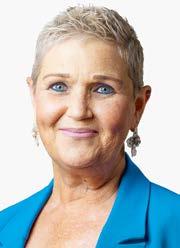
While the recent announcement of $40 million in drought resilience funding was welcomed, local leaders say it falls short.
“Our farmers don’t need resilience training — they’ve been resilient for two and a half years,” Greater Hume Mayor Lea Parker said this week
“They don’t want handouts either. What they want is the confidence to reinvest in their businesses and to know that their government values their industry.”
Regional leaders from Greater Hume Council and Snowy Valleys Council have now escalated calls for urgent drought policy reform, seeking to take their message directly to NSW Premier Chris Minns without delay.
Mayors Lea Parker and Julia Ham (Snowy Valleys) recently met with Federal National Party Leader Hon David Littleproud MP to raise the alarm over the devastating impact of two failed springs and a looming bob-tail season.
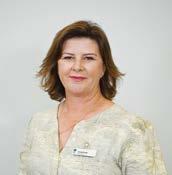
This week, they met with Hon. Julie Collins MP, Minister for Agriculture, Fisheries and Forestry, to continue building momentum for national drought recognition and reform.
FoodandbeveragebusinessesintheGeraldtonCBDarein thespotlightaspartofanexcitingnewcampaignfocused onthevibrantlocalhospitalityscene.
As part of the City of Greater Geraldton’s Stay and Play destination marketing campaign, the City has provided a free professional photography session to eligible venues to snap foodie photos for tourism marketing.
City of Greater Geraldton Mayor Jerry Clune is enthusiastic about the collaboration with local businesses.
“Geraldton’s foodie scene is awesome and by supporting our hospitality venues we can entice potential visitors to spend more time in our region and explore our city centre,” he said.
“This initiative is a fantastic chance to highlight the atmosphere, menu and unique character of our food and beverage offerings through the lens of a professional photographer whilst also providing local businesses with valuable promotional materials.
Images captured through the opportunity will be provided to participating venues and be used to promote the Visit Geraldton Food and Beverage Trail along with other destination mar-

keting efforts.
Participation is free, and 26 local businesses have opted to take part in this innovative campaign, which many will see in the new year.
They are now urging both NSW and Federal Governments to formally recognise drought as a natural disaster, unlocking emergency support and recovery measures.
“This is not just a dry spell — it’s a widespread crisis,” said Mayor Lea Parker.
“Our farmers are exhausted, financially strained, and emotionally broken. We need Premier Minns to hear directly from the communities bearing the brunt.”
Regional Leaders Are Calling For: Formal disaster recognition for drought, alongside floods and bushfires, Debt relief through RIC loans to enable reinvestment, Freight and fodder subsidies to ease immediate costs, Tax incentives for preparedness and long-term resilience During the 2018–2019 drought, the Regional Investment Corporation (RIC) delivered over $3.26 billion in concessional loans to more than 3,000 farm and small businesses — helping producers manage cash flow, refinance debt, and survive prolonged dry conditions. Remarkably, the program cost the
government just $1.655 million.
“RIC loans don’t just provide financial relief — they restore confidence,” Mayor Parker said. “They give farmers the breathing room to plan beyond the drought and invest in their future. They also support small businesses that rely on our rural ratepayers.”
The mayors also voiced concern over the Drought Hubs model, which has failed to deliver practical support to southern NSW communities. Funding has been concentrated in research and administration, while farmers continue to struggle.
With further meetings scheduled this week with Hon. Sussan Ley MP and Hon. Justin Clancy MP, regional leaders are building bipartisan momentum — but stress that state-level leadership is essential.
“We’re still hoping to get a seat at the table with Premier Minns,” said Mayor Parker.
“Our communities deserve to be heard — and helped.”
BananaShireCouncilhasproudlyreceivedtheLGMS RiskManagementExcellenceAwardatthe2025LGAQ AnnualConference,heldontheGoldCoastfrom20–22October.
The award recognises the Council’s approach to risk management throughout the delivery of the Moura Museum and Library Project.
The project represents a major capital investment, integrating the Moura Administration Office, Visitor Information Centre, Library, and the community’s Mining Museum into a single, multifunctional facility. It now serves as a cultural and service hub for the Moura community.
Council’s risk management strategy was a key factor in the project’s success.
This included:
· Extensive community and internal consultation
· A comprehensive risk management plan
· Careful design and cost considerations
· Collaboration with LGMS to manage construction phase risks
Through proactive planning and stake-

holder engagement, Council successfully reduced high-risk elements to a low-moderate level, ensuring the project was delivered on time and within budget.
Nev
accepted the award on Council’s behalf, acknowledging the collective effort and commitment of all involved.
TheCityofMelbournehassetthecourseforthenext25years–deliveringthecity’sfirstlong-termvisioninpartnership withthecommunity,backedbya4-yearplantoturnideasintoaction.
The Council has endorsed the M2050 Vision and Council Plan 2025–29, which was informed by over 2,000 contributions from people who live, work, study in or visit Melbourne.
The vision – Liveable Melbourne, growing stronger together – is underpinned by eight community aspirations for Melbourne’s future.
Lord Mayor Nick Reece said the Council was taking the first steps in it’s plan to bring this vision to life across wellbeing, infrastructure, culture and creativity, economic investment, sustainability and governance.
“Our new Council Plan outlines six ways we’re making Melbourne the best and fairest city – bringing our shared vision to life,” he said.
“More than just a piece of paper, our Vision and Plan connect our everyday decisions and actions to something much bigger – the long-
term future we’re shaping together for our city.”
“We’re already one of the world’s most liveable cities – but we didn’t get there by standing still. To ensure Melbourne continues to be a world-class city, we need to keep delivering on the vision shaped by our passionate, caring community.”
“To everyone who shared their ideas – thank you. From bold suggestions in workshops to personal stories in submissions, this Vision and Plan belong to all of us, bringing us together as we strive for a better Melbourne.”
The four-year plan focuses on the short to medium-term activities Council will deliver under six priorities, and indicators to show we’re on the right track.
The six priorities are:
· Healthy, safe, clean and connected communi-
ties
· Building a city for people
· Vibrant and creative Melbourne
· Leveraging our economic strengths
· Living sustainably
· Governing for our future
During the final stage of community consultation, 90 per cent of respondents ranked healthy, safe, clean and connected communities as their top priority.
One measure of success will be closing the gap between those who know how to access support services – such as food relief, wellbeing and homelessness support – and those who choose to use them.
Around 85 per cent of respondents said living sustainably and building a city for people were important priorities. These will be mea-
sured in part by the amount of new open space and canopy cover Council delivers, and by how many new homes meet high standards of design quality.
Meanwhile, 82 per cent of respondents said a vibrant and creative Melbourne was important. Council will track this through participation in arts and cultural activities and the number of creative jobs in the city.
Council will report against these outcomes every year – with a shared responsibility across Council teams to contribute to their success.
Council also endorsed the financial and asset plans for 2025–35, setting a clear strategy for managing more than $4 billion in critical community assets – and investing where it matters most.
For more information, visit City of Melbourne.
TheCityofBelmonthasunveiledafive-yearplantoboostsafety,launchingitsCommunitySafetyStrategy20252030afterreceivingtheCouncil’sgreenlightinAugust.
The strategy sets out a roadmap for the City to deliver, empower, partner and advocate for safer neighbourhoods, with Mayor Robert Rossi declaring community safety a top priority.
“Even though we aren’t the police, we are working closely with them, advocating, and supporting their efforts in every way possible. A safe, strong, and resilient community is what every resident deserves, and it’s what we strive for every day,” he said.
“Our new strategy builds on what’s already working, like CCTV and 24-hour security patrols, and introduces fresh initiatives to empower our residents. It also focuses on prevention and tackling the root causes of safety issues, helping our community stay strong and resilient,” he said.
The City’s approach leans heavily on partnerships, notably with WA Police.
Mayor Rossi highlighted the strong working relationship with officers at Belmont Police
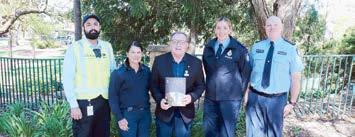
Station, vowing to continue backing local police efforts to curb crime.
“Our ongoing support for the WA Police
All five motions presented to the Queensland Local GovernmentConference(LGAQ)AGMbySunshineCoast Councilhavebeensupportedbyanoverwhelmingmajority.
Sunshine Coast Mayor Rosanna Natoli and Deputy Mayor Maria Suarez were the Council voting delegates at the meeting.
One of the motions presented today (Wednesday), called on the State Government to investigate and develop options for managing the long-term storage of recreational vehicles such as caravans, trailers, boats and mobile homes on local roads.
The motion was supported by the membership and will now form part of the LGAQ’s advocacy platform on behalf of councils and their local communities.
The aim is to address growing concerns around safety, parking capacity and neighbourhood amenity across many Queensland communities. However, the current legislative framework does not provide councils with practical tools to manage this issue effectively.
Mayor Natoli spoke to the motion asking delegates to support a push for the LGAQ to advocate to the State for options allowing councils to manage the storage of recreational vehicles on roads.
“This is an issue impacting our council and others across the state with residents complaining about safety concerns, a lack of available parking and neighbourhood streets that are clogged and ugly,” she said.
“We receive 700 complaints a year plus thousands of signatures on petitions and we are not alone.
“We are calling for the State Government to assist us with legislation to manage this for our communities.”
This now means the LGAQ will add this item to its agenda for advocacy work in the year ahead.
There will be no immediate changes to any policy.
“There is a long way to go and there will opportunity for public consultation before any changes are progressed,” Mayor Natoli said. Other motions presented and supported include:
1. Motion 20 - Funding to provide supported accommodation models (supporting options to address homelessness)
2.Motion 70 - Investigating options for managing the storage of recreational vehicles on roads (this is now a composite motion with Gold Coast City Council)
3.Motion 82 - Enhancing Federal funding for local biosecurity efforts against fire ants
4.Motion 102 - Enhancing State and Federal Government support for roadside litter management
5.Motion 116 - Technical design guidance for climate resilience for Queensland Councils (this is now a composite motion with Fraser Coast Regional Council)
Force is a win-win. We’re committed to assisting them in their important work wherever possible, this includes continuing to fund a
family violence support worker at the police station to help local families when they need it most,” he said.
Senior Sergeant Matt Fogarty of Belmont Police Station echoed the sentiment, pointing to the value and united efforts of the Belmont Family Violence Support Service and the City’s CCTV network, into complex community challenges.
“Creating a safer community requires collaboration between police, government agencies, organisations, businesses, and community stakeholders and members.
“The City’s ongoing support, resources, and local insights are invaluable to our work. They not only assist our efforts but also help educate the public on ways to foster safer neighbourhoods,” he said.
For more information on the Community Safety Strategy 2025-2030 visit the City of Belmont’s website.
TheCityofMelville’sforeshorecareandrestoration workhaslandedittheCoastalPlanningandDesign Awardatthe2025WesternAustralianCoastalAwards forExcellence,heldonMonday,27October.
City of Melville Mayor Katy Mair was excite by the win.
“I’m thrilled that the City has been recognised for our Melville Beach Road Bioengineering Project, claiming the Coastal Planning and Design Award at the 2025 Western Australian Coastal Awards for Excellence,” she said.
“With more than 18km of foreshore spanning across the City of Melville, we know that these are important places for our community, and for the City it’s critical that we continue to protect and enhance our natural environment.
“It’s fantastic to see the great outcomes from the Melville Beach Road Bioengineering Project including enhancing biodiversity and habitat connectivity, and I’m looking forward to seeing more foreshore management which protects our environment.”
In line with the City’s priority to protect and enhance the natural environment, the City’s Melville Beach Road Bioengineering Project in Applecross was recognised for exemplifying innovative bioengineering techniques, including brush log walls, tied into rock toe protection, and extensive native
vegetation restoration.
Bioengineering uses centuries old techniques that have proven effective to manage erosion from shoreline streamflow forces and allow the opportunity for native plants to become established, decreasing the reliance on rock revetments through sustainable, natural erosion control solutions.
The project began in April 2024 and has seen achievements such as:
· 90 per cent survival rates for non-irrigated native plants, enhancing biodiversity and habitat connectivity.
· Zero environmental incidents during construction, with rigorous safeguards protecting Swan River water quality, like deployment of silt curtains.
· Integration of sustainable practices, such as natural material use and climate-adaptive design for a 25-year lifespan.
· Improved community access via limestone stairs and universal accessibility features, balancing ecosystem restoration with public amenity in a high demand space for recreational users.
Thisyear’sWasteExpoAustraliasawmorethan4,000attendeesthroughthedoorsovertwodaysattheMelbourne ConventionandExhibitionCentre,withanoverwhelmingemphasisoncircularityandsustainableresourcerecovery dominatingdiscussionsacrossboththeexhibitionandconferenceprograms.
More than 150 exhibitors showcased industryleading waste management and resource recovery solutions, with exceptional professional development opportunities and thought leadership on offer from over 110 speakers across 45 conference sessions spanning the Waste Expo Summit and the co-located ecologiQ Greener Infrastructure Conference.
Right from the start of the standing-roomonly Government and Policy stream, conversations were focused on the urgency and necessity of a circular economy in Victoria and the wider Australian economy.
Tony Circelli, CEO of Recycling Victoria, opened discussions with statistics highlighting progress in circular economy initiatives, like a material recovery rate of 70 per cent for the state, along with a doubling of the number of containers seen through the Container Deposit Scheme in its second year.
Following the opening panel discussions on circular economy challenges and opportunities, Matt Genever, CEO of Sustainability Victoria, reinforced the importance of community engagement and cross-sector collaboration in driving the transition to a circular economy.
“Social license is so important. We need the community to understand why we’re trying to do the things that we do,” he said.
“And an event like this becomes that melting pot where we’ve got industry, government.
“We’ve got a government lounge right here where industry can come and talk directly to government colleagues. We’ve got community here, and that’s what we need, those conversations happening between individuals, businesses, and government. Waste Expo provides an amazing platform every year for us to be able to do that.”
Echoing this theme of community engagement in the Summit’s Waste-to-Energy stream, Scott Reynolds from Kwinana Energy Recovery discussed how Australia’s first operational energy recovery facility is transforming waste management by diverting waste from landfill and recovering energy for the grid, while sharing operational lessons with other organisations preparing for their own energy recovery journey.
Reynolds emphasised that collaboration and engagement has been fundamental to the facility’s success, particularly in demonstrating how energy recovery technology complements recycling and other sustainable waste management practices.
“In a society where we have a greater focus on sustainability, being able to explain how complementary energy recovery is to other parts of the whole waste management process and hierarchy is really important in terms of bringing our communities along on this journey,” he said.
The Circular Economy stream of the Waste Expo Summit highlighted the critical need for mandatory Extended Producer Responsibility (EPR) regulations and national standards to create a level playing field for recyclers and brand
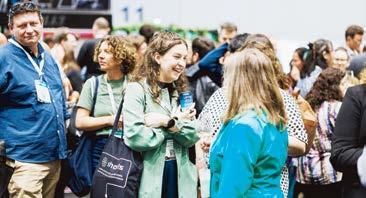


owners. Key challenges included ensuring material purity and traceability, addressing safety risks in e-waste handling, and building systems-thinking approaches across entire supply chains with proper education and infrastructure investment.
Circular Australia CEO Lisa McLean, chaired the Circular Economy stream on day one, and noted a unified message of the need for regulation as fundamental to enabling the circular economy in Australia – from plastics to e-waste and solar panels.
“Mandatory extended producer responsibility laws and regulations were a really big theme at Waste Expo Australia, with strong support across these sectors for that regulatory and policy piece. It’s essential to creating a level playing field for the entire industry, from government to private enterprise and recyclers.”
For the first time in 2025, the ecologiQ Greener Infrastructure Conference co-located


with Waste Expo Australia, bringing together the resource recovery and sustainable infrastructure sectors in a strategic partnership that bridges the gap between resource recovery, sustainable infrastructure and large-scale government projects.
EcologiQ is at the forefront of integrating recycled and reused materials into road and rail infrastructure projects across Victoria. The conference showcased how the transition to purposely greener infrastructure is accelerating, driven by decarbonisation targets and circular economy principles supported by the Victorian Government’s Recycled First Policy.
Yas Grigaliunas, CXO of Videopro and former founder of Circonomy, led a keynote to start the ecologiQ conference, summarising her startup journey through the circular economy as a fullcircle story of believing, building, scaling and failing. She encouraged attendees and other potential founders that events like the Greener Infrastructure conference were what moves the




entire circular industry forward.
Exhibition Manager Sherri Pearson said Waste Expo Australia continued to grow thanks to its relevance, strategic industry partnerships, and ongoing adaptation to industry trends.
“The success of Waste Expo Australia is driven by its ability to bring together the most influential players in the sector, and future editions will focus on expanding international reach and providing even more value to attendees and exhibitors,” she said.
“Next year’s event will see exciting enhancements focused on the latest technologies and solutions being developed globally. As part of an international portfolio of events, Waste Expo Australia will continue to be the industry’s mustattend event.”
Waste Expo Australia will return to the Melbourne Convention and Exhibition Centre on 28-29 October 2026. Stay up to date at www. wasteexpoaustralia.com.au.
ThepeopleofCentralDarlingShirehavetheirfirstCouncilin12years,withtheNSWMinisterforLocalGovernment RonHoenigconfirmingthethreepeopletoserveasappointedcouncillorsalongsidethecouncillorselectedbythe community.
The new Rural and Remote Council model will enable the Council to draw on a wide range of expertise to ensure that it can address the challenges of service provision in a remote location.
Central Darling will have an equal mix of elected and appointed councillors to ensure strong local representation while maintaining stable governance.
NSW Minister for Local Government Ron Hoenig said this new model was introduced by the Minns Labor Government to address the unique challenges of larger remote councils and to provide a pathway back to democratic representation for Central Darling Shire after 12 years of administration.
“Returning democratic representation to Central Darling Shire after 12 years under administration was a key priority for the Minns La-
bor Government and I’m very proud that we’ve reached this point,” he said.
“I congratulate both the elected and appointed councillors of Central Darling Shire and I wish them well in their new roles serving this community.
“Central Darling Shire faces unique challenges. The government will continue to work closely with the Council to ensure it has the support it needs.
“I expect all councillors to work together to serve the community, and I look forward to seeing them get down to the business of running the Council.”
Following the election for the Council’s three wards, Peter Sullivan was elected to Ward A, Max Bradley to Ward B, and Daniel Fusi was declared elected uncontested in Ward C.
The three appointed councillors were determined by the Minister after the election results were declared, to ensure their skills and experience will complement those of the elected councillors.
The appointed councillors are:
· Robert (Bob) Stewart – Mr Stewart has served as the Administrator of Central Darling Shire Council since 2019, conducting day to day business during this challenging time which has included fish kills, drought, and floods. Bob has over 40 years of local government experience and understands the specific financial, socioeconomic and environmental challenges for the region.
· Fiona Kelly – Ms Kelly is a proud Barkindji/ Ngiyampaa woman and Executive Principal of Menindee Central School which she also at-
RoperGulfRegionalCouncilproudlywelcomedtwonewAustraliancitizensduringa specialCitizenshipCeremonyheldinMatarankaonTuesday,4November2025.
The ceremony, presided over by Mayor Tony Jack, was held in the Mataranka Community Hall and marked Council’s first citizenship ceremony since June 2023.
The two conferees, one originally from New Zealand and the other from the United Kingdom, have each called Mataranka home for
several years and are well known within the local community. Both made their pledge of commitment before Mayor Jack and received their citizenship certificates surrounded by family, friends, Councillors and Council staff.
Mayor Jack said it was an honour to officiate the ceremony and to share this significant
milestone with the region’s newest Australians.
“It’s a privilege to officially welcome our newest citizens into the Roper Gulf community, and I wish them every success as they begin this new chapter of their lives.” Mayor Jack said.
tended as a student. Ms Kelly has dedicated herself to culture and community, and her leadership at Menindee Central has seen a number of positive changes.
· The Hon. Barbara Perry – Ms Perry is a former Auburn Councillor, served 13 years in NSW Parliament as the Member for Auburn and served in several Ministerial roles including Minister for Local Government from 20082011. She has a legal background and has significant experience in governance and interaction with the State government
